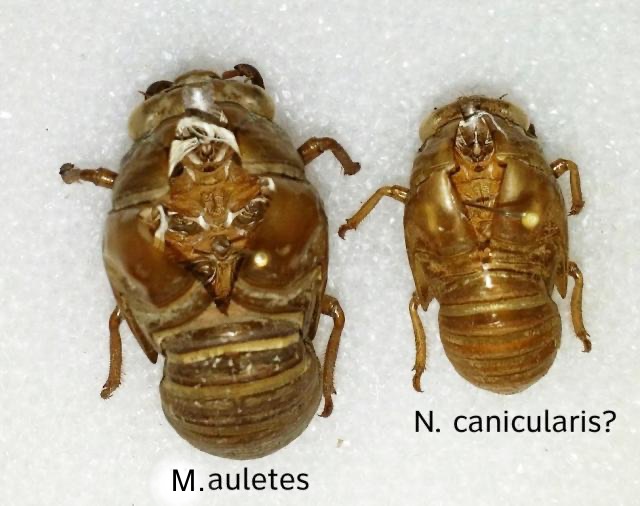
A photo of a Megatibicen auletes compared to a smaller Neotibicen exuvia (I believe it is an N. canicularis based on the time of year and location (mid-New Jersey)).
Dedicated to cicadas, the most amazing insects in the world.

A photo of a Megatibicen auletes compared to a smaller Neotibicen exuvia (I believe it is an N. canicularis based on the time of year and location (mid-New Jersey)).
One of the most frequently asked questions we receive is: “what do cicadas do“? This question is similar to the question “what is the purpose of cicadas” — the answers to both questions help people understand why these fascinating, unusual creatures exist at all.
The simplest reduction of their life cycle is:
1) They hatch from an egg.
2) They burrow underground where they will drink from plant roots for most of their lives.
3) They leave the underground and become adults.
4) The males make sounds that attract females.
5) Males & females court & mate.
6) Females lay fertilized eggs in the branches of plants, and the cycle continues.
7) They die.
The specifics of a cicada’s life cycle varies from species to species, but here is a more detailed view of what cicadas do:
From egg to 1st instar nymph:
1) Cicada nymphs hatch from eggs.
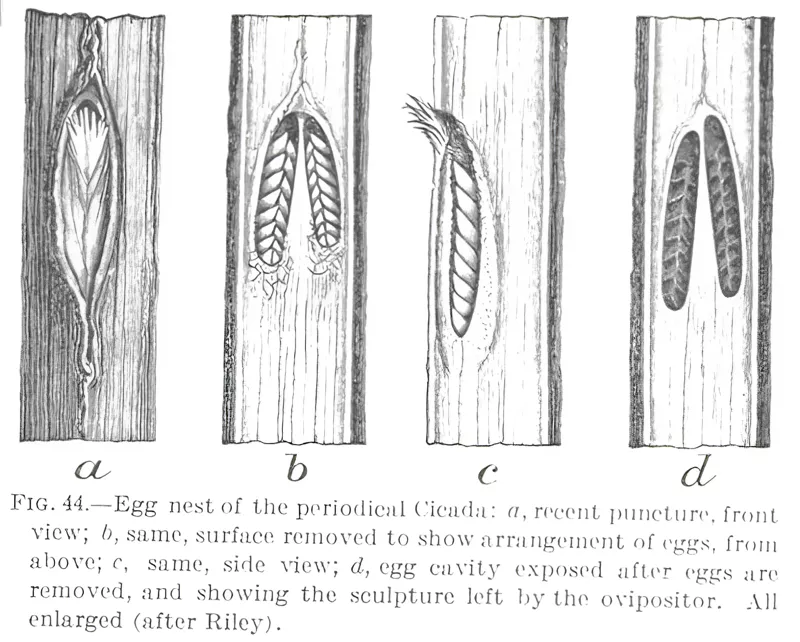
2) Nymphs feed on plant fluids which they access thanks to the egg-nest groove made by their mothers.
3) They leave the groove, and drift to the ground. Their descent to the ground doesn’t hurt them because they weigh so little.
4) Once on the ground, they dig into the soil until they find small rootlets, from which they will feed.
Once Underground:
5) Underground, they will tunnel/dig…
6) and establish a cell…
7) from where they’ll comfortably feed. Cicadas feed on the xylem sap of plants. With the help of bacteria they transform the water, minerals and amino acids found in tree fluids to the tissues of their own bodies.
8) They pee, in fact they seem to use excess plant fluid to moisten soil to help mold the walls of their cells.
9) Throughout their life underground they will move from root to root… as plant root systems change with the seasons, when roots die off, or perhaps to avoid predators.
10) Underground, a cicada may (depending on the species) go through four instars, molting three times (see an image of the four instars).
Preparing to emerge:
11) Cicadas will build a tunnel to the surface of the ground, in preparation for their emergence.
12) Cicadas often take that a step further an build a chimney/turret above ground. This often happens in shady areas or when the ground is muddy.
Once above ground:
13) They emerge from their tunnels…
14) Cicadas run as fast as they can…
15) And find a surface perpendicular to the ground, hold tight, and begin to molt…
16) During the molting process (ecdysis), cicadas perform many acrobatic moves to separate themselves from their nymphal skin, including pulling their old trachea from their bodies.
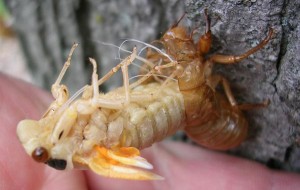
17) Once outside their nymphal skin, they will inflate their wings…
18) … and expand various parts of their bodies, like their heads.
19) They will change color.
20) Once their bodies are hard enough (sclerotization counts as a thing they do)…
21) They will either seek shelter, perhaps by crawling up higher along a tree trunk…
22) or if your are a Magicicada, you might stick around in the hopes that a predator will eat you.
Mating and Reproduction:
23a) If you are a Male cicada, you are going to sing… unless you belong to a species that cannot sing, in which case, you’ll move your wings in a way that will produce a sounds.
There are many types of songs: a) distress calls, b) calls to establish territory, c) calls to attract females, d) including choruses of many cicadas and e) courting calls
23b) Female cicadas, and some male cicadas, move their wings to make sounds, also in an effort to attract and engage a mate.
24) Most cicadas (aside from Magicicada during the early days of their adult lives) will try to avoid being eaten by predators.
25) They’ll fly, of course.
26) Cicadas, like Magicicada, will establish chorusing centers, which are places where the male cicadas sing together and females come to meet them.
27) Male and female cicadas will court…
28) and mate…
29) the female cicada will lay her eggs in grooves (ovipositing) she etches into a suitable plant stem, and we’re back to step 1.
30) The last thing cicadas do, of course, is die, and return the nutrients found in their bodies to the soil, where they will be broken down and absorbed by the plants they fed upon.
Here are some things cicadas do not do:
1) They don’t seek shelter during the fall months (i.e. they don’t try to live inside your house), unlike Ladybugs or Stinkbugs.
2) They don’t sting or otherwise pass venom onto people.
3) They don’t chew plant leaves, like caterpillars or grasshoppers.
4) They don’t dump garbage in the ocean.
Is it true that someone has offered a reward for a white or blue-eyed Magicicada cicadas?
This was false and an urban legend until in 2008 when Roy Troutman began to offer rewards for living blue-eyed cicadas for scientific research. All cicadas were released, unharmed.
Important: Roy is no longer offering the reward as he has obtained the cicadas needed for his research. So, don’t bug him, unless you want to tell him that his photos and video are awesome.
White or Blue-eyed Magicicadas cicadas are extremely rare, so finding them can be difficult. I usually find one per emergence, and that is after looking at thousands of cicadas.
Speaking of Roy and White-eyed cicadas, here is a video Roy took of a White-eyed cicada:
And here’s a white and orange-eyed cicada photo taken by Roy:
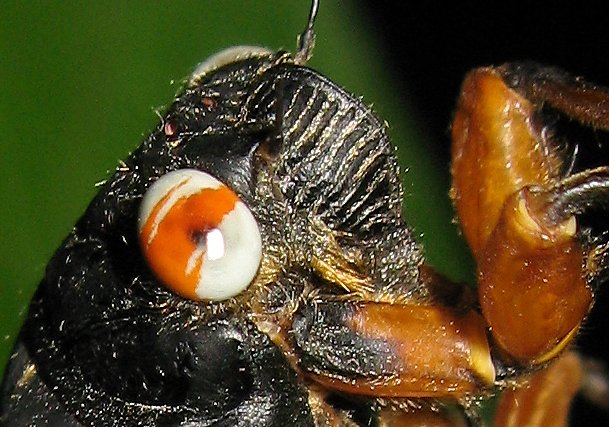
Cicadas “eat” / drink something called xylem (sap), which is a watery tree fluid containing amino acids and minerals. Cicadas drink rather than eat.
People probably ask “what do cicadas eat” because they are afraid that cicadas will eat their flowers and garden fruits and vegetables. Cicadas lack mouthparts that can chew and swallow vegetation. Your tomatoes and marigolds are safe.
How does a cicada drink xylem? The cicada’s mouth parts (aka rostrum or beak) are in the shape of a straw, which can pierce rootlets, roots and branches.
Cicadas are able to derive nutrition from the xylem thanks to bacterial endosymbionts that live in the cicada’s gut.
Cicadas are known for drinking xylem from tree roots (as nymphs) and branches & twigs (as adults), however, when they are small they must rely on grasses, and possibly other small plants for nourishment.
Perhaps the reason why periodical cicadas are “attracted to woodland edges and exposed aspects, especially for chorusing and ovipositing” (1) is their offspring will be more likely to find the roots of grasses in those areas. Young nymphs would be unlikely to find suitable tiny roots deep in a shady forest.
Once the cicada nymph is larger, they can burrow to larger and more permanent tree roots, and feed on there.
It is interesting to note that not all cicadas feed on trees. Some feed on sugarcane, which is a giant grass (we’re back to the grasses again). The Brown sugarcane cicada (Cicadetta crucifera) and Yellow sugarcane cicada, (Parnkalla muelleri) of Australia feed on the sugarcane plants and cause damage to plants.
Read more:
Sources:
More than a few people have asked Cicada Mania: “do cicadas pee”? Absolutely, cicadas do pee. There are a couple of reasons why:
You may have been under a cicada-filled tree on a sunny day and felt a sprinkle or two. Don’t worry, it is just watery tree sap (xylem) passed through a cicada.
A detailed explanation of the experience courtesy of Les Daniels:
I’ve experienced this several times where I was on the receiving end of this artificial rain. When many cicadas congregate on warm days, they feed on the tree fluids and often urinate ‘piss’ while doing so. This bug urine is called ‘honeydew.’ The little buggers have pelted me several times while I was observing a little ‘too’ close. It isn’t uncommon. Lastly, the ‘honeydew’ does not stain or stink. In fact, it feels like raindrops.
Some cicadas seem to pee more than others, for instance, the Chremistica umbrosa of South-East Asia. If you walk under an umbrosa, you will need an umbrella! (The Latin root of both words, umbr means shade). Here is a video of Chremistica umbrosa:
Sources:
1 Records Of The Cicada, Chremistica Umbrosa (Distant, 1904) In Singapore, With Accounts Of Its Mass Emergence (Homoptera: Cicadidae: Cicadinae), Tzi Ming Leong, Aminurashid and Benjamin P. Y-H. Lee, NATURE IN SINGAPORE 2011 4: 163—175, 15 June 2011
2 The Ecology, Behavior, And Evolution Of Periodical Cicadas, Kathy S. Williams and Chris Simon, Annu.Rev. Entomol. 1995. 40:269-95
3 The documentary The Queen of Trees by Deeble & Stone features a segment about Fig Cicadas, that expel pee, sweet with the phloem sap of the fig tree, which is enjoyed by ants and monkeys, which has the side benefit of keeping those predators and nuisances away.
Yes, cicadas can see. People might assume that cicadas cannot see because they are slow to move when approached or are easy to capture.
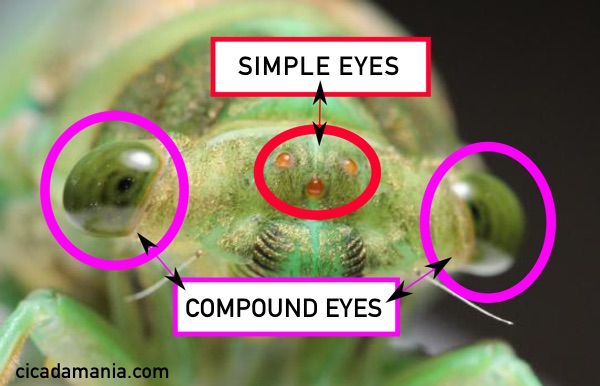
Cicadas have 5 eyes. Two large compound eyes, which are used to visually perceive the world around them, and three small, jewel-like, simple eyes called ocelli. We believe the ocelli are used to perceive light & darkness. The fact that there are three of them, arranged in a triangle, may help them triangulate the direction of the sun or the movement of a shadow.
The reason they are easy to capture right after they have molted is that their body parts are not hardened and ready to react quickly. The reason they are easy to catch once their bodies are hardened is often that they want to be caught, due to a species survival strategy called predator satiation (more on that in a future article).
No. When many types of cicadas first emerge from their nymphal skin they are white in color. Gradually, their bodies become a darker color. Some take longer than others to change. Some die before the change can occur, and their corpses remain white.
This is a photo of a teneral (soft) Magicicada:
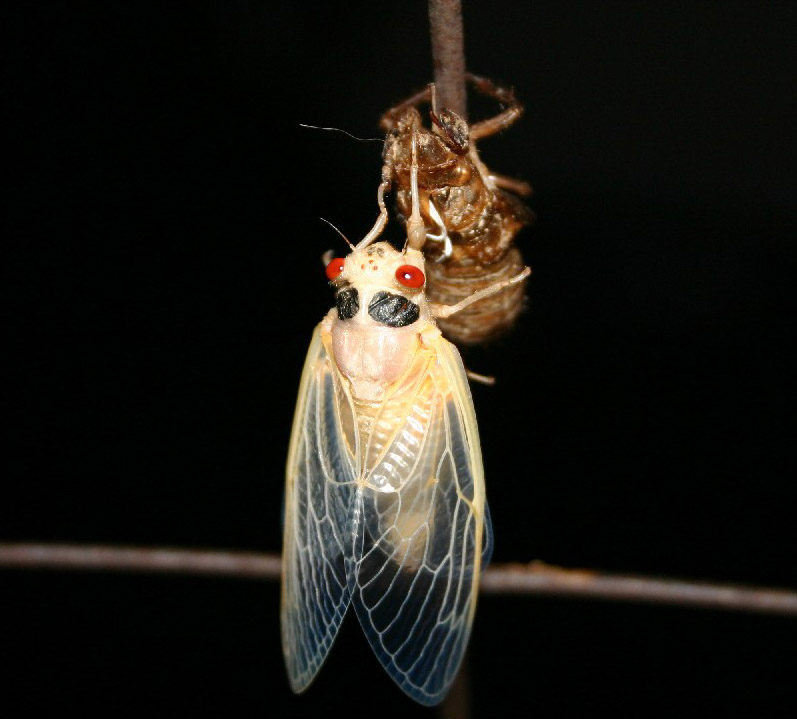
Its skin will eventually turn black and orange.
The are some cicadas, like the Tibicen pruinosus fulvus Beamer, 1924, that retain their lighter, teneral colors, but they are not albinos. Note: fulvus means yellow.
Here is how to tell the difference between a male cicada and a female cicada (for most species):
1) Only males sing. If the cicada is singing, it is a male.
2) Look at their abdomen. If it comes to a point and has an ovipositor, it is a female.
This is an image comparing the abdomens of male and female Magicicada cicadas.
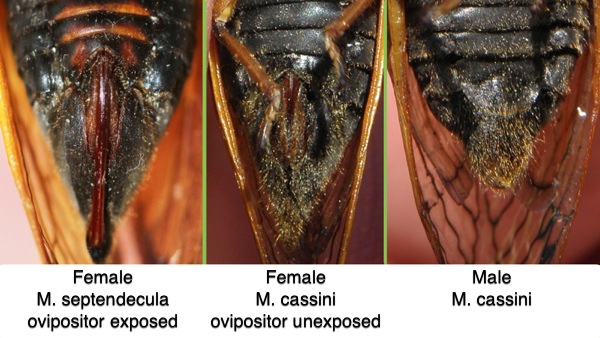
This image compares a male and a female Neotibicen lyricen. Note the difference in the curvature of the 7th sternite, the shape & location of the tymbal covers of the male, and the valvulae & ovipositor of the female.
Male and female Neotibicen:
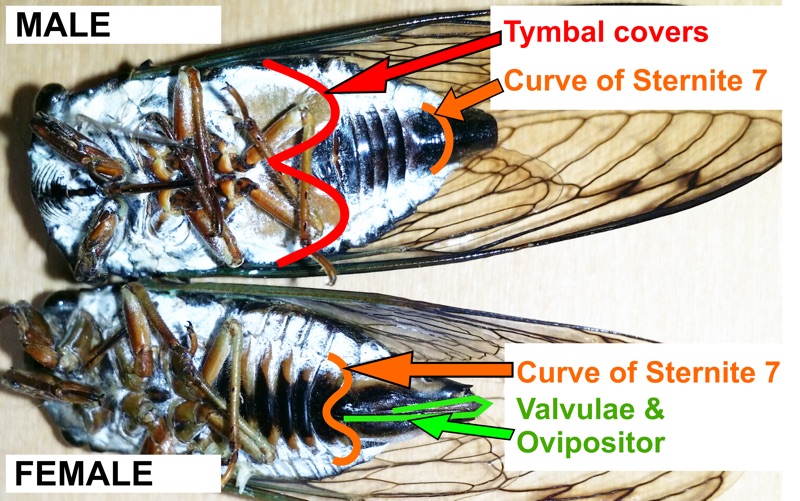
Also, if the cicada is laying eggs in the branch of a tree, that’s proof that it’s a female. Here is a video of that:
Update: John Cooley shared his thoughts about this article about the Hodgkinia symbionts. There is a lot more work in this area of research yet to be done.
Update: McCutcheon (Matthew A. Campbella, James T. Van Leuvena, Russell C. Meister, Kaitlin M. Carey, Chris Simon, and John P. McCutcheon) has a new paper that shows Magicicada may have between 20 to 50 variants of Hodgkinia in their gut! Read the paper here. It would seem that the longer the life cycle, the more variants of Hodgkinia will be present in cicadas.
Here is the species used in the study: Magicicada tredecim:
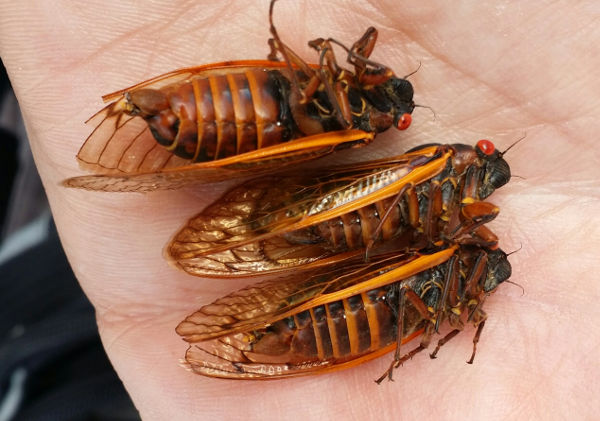
From the October 5th, 2014 post:
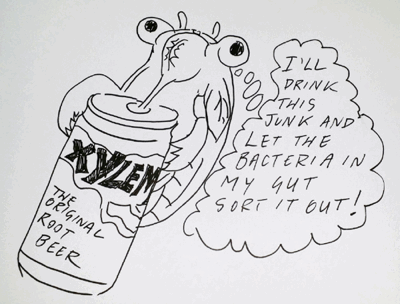
Most people know how termites rely on microbes in their gut to break down the wood they consume into nutrients their insect bodies can use. Even human beings benefit from bacteria to help digest certain carbohydrates, fight pathogens and produce certain vitamins (like K and B12).
Cicadas also benefit from microbial endosymbionts. Cicadas, for most of their lives, consume a diet of xylem sap, drawn from the roots of trees. There are two types of sap: xylem and phloem. Phloem is the delicious, sugary one — in Maples, it’s Maple Syrup. Xylem is the “Diet” version of that. Thankfully cicadas have bacteria in their gut that process the xylem sap into nutrients cicadas can actually use.
Recently it was discovered that one such bacteria (Hodgkinia) has become two distinct bacteria in some cicadas belonging to the genus Tettigades. This discovery was documented in the paper Sympatric Speciation in a Bacterial Endosymbiont Results in Two Genomes with the Functionality of One by James T. Van Leuven, Russell C. Meister, Chris Simon, John P. McCutcheon (link http://www.cell.com/cell/abstract/S0092-8674(14)01037-X).
 What’s interesting is the Hodgkinia bacteria became two distinct species for no particular discernible reason (nonadaptive evolution). Separate, either of the species would be useless to the cicada because they produce an incomplete set of nutrients, but together they produce the compete set of nutrients. Two function as one, that once was just one. Ed Yong does a thorough job of explaining this on National Geographic. According to Yong’s article McCutcheon thinks they know how it happened (explained in the article and paper). Why it happened is another matter — of course how and why might be the same thing deep in the soggy bowels of a cicada.
What’s interesting is the Hodgkinia bacteria became two distinct species for no particular discernible reason (nonadaptive evolution). Separate, either of the species would be useless to the cicada because they produce an incomplete set of nutrients, but together they produce the compete set of nutrients. Two function as one, that once was just one. Ed Yong does a thorough job of explaining this on National Geographic. According to Yong’s article McCutcheon thinks they know how it happened (explained in the article and paper). Why it happened is another matter — of course how and why might be the same thing deep in the soggy bowels of a cicada.
Chris Simon, let me know that she is working on a paper that will discuss bacteria found in Magicicada. It will be interesting to learn what they find in the bellies of those long-living cicadas.
Cicadas spend most of their lives, as nymphs, underground. The large forelegs of cicada nymphs are adapted to digging through soil.
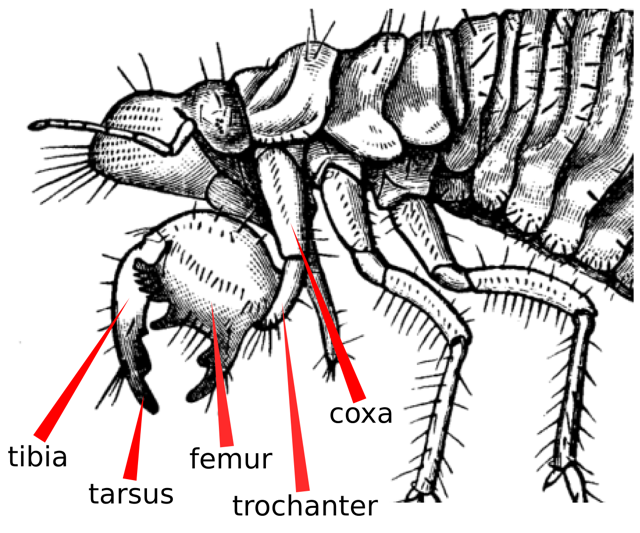
Image from The Periodical Cicada: An Account of Cicada Septendecim, Its Natural Enemies and the Means of Preventing Its Injury by C.L. Marlatt. 1898.
These videos demonstrate Magicicada nymphs digging through soil.
This magicicada nymph is excavating a make shift tunnel sandwiched between two pieces of plexiglass.:
Magicicada nymph emerging from burrow from Roy Troutman on Vimeo.